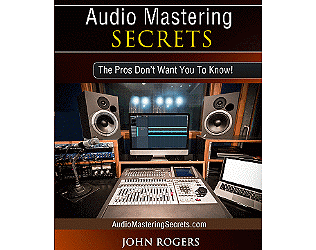
The Best Audio Mastering Book, Video, and Course by John Rogers
Member Login

Let Me Show You How To QUICKLY Master Your Songs To Professional Radio Quality Standards! Improve Your Songs TODAY!
Hello, my name is John Rogers owner of JR mastering and author of the current #1 Best Selling Audio Mastering Book on Amazon.com which is now available in a video course! Since 1999, I've worked with over 8,000 satisfied clients (that's 6-8 per week). I've also mastered music for grammy award winners, several songs charted #1 in Europe, and my masters have been played by DJs all over the world.
Book Pages
Before I tell you the setup I like best, after many years of experimentation, I'd like to first tell you the setup I personally don't like (even though a lot of sound engineers do this). Two studio monitors, five feet apart, on a desk two feet away from their face. And NO sub-woofer! I think they call this "near field" monitoring. But at some point during the audio mastering process, you must crank the music up very loud to set your final compression and to hear how it translates at high volume levels. You can't do this if your speakers are right next to your ears! At least I can't.
Maybe this is why the songs I get in for re-mastering badly break up when cranked up loud, and the bass is totally washed out. They were originally mastered at very low levels without a sub-woofer, and not optimized for loud playback.
I also find it hard determining the overall depth and stereo width in music when the speakers are two feet in front of me. Which makes sense. Its like watching a 50" TV. I want it to be far enough away so I can take the whole picture in. No one puts a 50" TV on a table right in front of them, yet this is done with speakers.
I've used dozens of different brands of speakers in my career and I do like a few better than others. But, this article deals more with types and sizes of speakers, not with the brand choices.
The main mixing and mastering speakers I currently use are Dynaudio 100w powered studio monitors with 7" woofers and 1.1" tweeters. They have nice EQ adjustment options on the back and I know these speakers very well. If you get speakers that are a little bigger, you'll get better LOW-end out of them, but I'm happy with the size I use.
The most important part of your speaker setup (that a lot of newbies don't know about) is having a sub-woofer on the floor between your main studio monitors. It's impossible to correctly mix or master any music content under 150hz without having a sub-woofer. 7-8" studio monitors will not play the low 50hz sub-bass AT ALL, and they're weak at best in the 100hz area.
Technically, you can properly mix or master in any room size. But, I believe a smaller room is better than a very large one for someone who's just starting out. And when I say smaller I mean closer to 12'x15' than to 20'x30'. I've mixed and mastered songs for a number of years in a 20'x30' room. It took me a few days to get used to it, but after that I could do it.
The obvious problem with a big room is it's a very open space. If you don't have a good acoustic setup, the room will add reverb to every song. You have to compensate for this on every song you mix or master, because the extra reverb you hear isn't really in the music. It's coming from the room.
In a smaller room, even with no acoustic treatment, your mixes and masters will all sound more true. They won't be discolored from bouncing around a big room.
A Mid-Side Effects Processor lets you target two different parts of the stereo field. The outside and inside (center) of the stereo field. These two ranges are preset and you don't have the option to change them, nor do you know specifically what the ranges are. From my experience, I would say CENTER usually covers roughly the range of L70 to R70. The SIDES are L to L71 and R71 to R.
WHY WOULD YOU NEED THIS? WHEN WOULD YOU USE THIS?
1. I use a Mid-Side Processor mostly to check the stereo field of a mix. I use the Mid-Side 5-Band EQ and solo the SIDES. If I don't hear much musical content on the sides (or only light reverb), the mix has a weak stereo spread and is basically a mono mix. I then either ask for a remix or boost whatever is on the SIDES (which usually doesn't achieve much).
2. Sometimes a client mixes their stereo guitars (or background vocals) very loud and they overtake the entire song. A Mid-Side 5-Band EQ can easily fix this problem by cutting only the SIDES down a few dbs. Or by boosting the CENTER.
3. If the lead vocal is buried by guitars and the guitars are stereo panned well, sometime a Mid-Side 5-Band EQ boost around 2-3k in the CENTER will bring the vocal out. You could also combine this with a SIDE cut.
Note - For mastering, I only use a Mid-Side 5-Band EQ, NOT any other Mid-Side Processors. And when I do use it, it's only for the few instances I mentioned above.
The title pretty much explains it. You're listening back and forth between a commercial industry standard reference song and the song mix you're mastering, comparing sonic qualities between the two. How does the song you're mastering differ from the commercial reference song?
As you master a song, your goal is for it to sound more and more like the industry standard reference song in every sonic area. You continue listening back and forth, while adding effects until you come as close as possible to replicating it. I say as close as possible because if a the mix you're working on is very poor, you won't be able to replicate it.
A/B comparison is "trial and error testing against the reference track." That's what you're doing in effort to match it.
It's funny how this works, but after you do this a while, the industry standard reference track is in your head! You know exactly where each sonic quality is supposed to be and how to quickly apply the effects needed to get your master there. When you reach this point, this is when you can master songs a lot faster.
More Music Resources
- If you're looking for discount Mixing and Mastering Services, check out my former employee Brett Anderson
- Rankings and Reviews of the Best Music Production Services
- Preview Audio Mastering Secrets Free PDF
- Preview Audio Mastering Books Free PDF
...
More Music Resources 2
- Get a Free Master of your Song.
- Check out the Best Mixing and Mastering Blog

